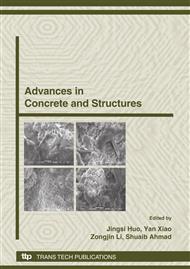[1]
M.S. Medhekar, D.J.L. Kennedy:Displacement-based seismic design of buildings: theory . Engineering Structures, Vol. 22(2000)No. 2. pp: 201-209.
DOI: 10.1016/s0141-0296(98)00092-3
Google Scholar
[2]
T.B. Panagiotakos, M.N. Fardis. A displacement-based seismic design procedure for RC buildings and comparison with EC8. Earthquake Engineering and Structural Dynamics, Vol. 30(2001), pp: 467-479.
DOI: 10.1002/eqe.71
Google Scholar
[3]
Timothy White, Perry Adebar. Estimating rotational demands in high-rise concrete wall buildings. 13WCEE, Paper 935, Vancouver, BC, Aug. (2004).
Google Scholar
[4]
Jorge Gutierrez, Mauricio Alpizar. An effective method for displacement-based earthquake design of buildings. 13WCEE, Paper 1512, Vancouver, BC, Aug. (2004).
Google Scholar
[5]
W.B. Luo etc. Displacement-based Seismic Design for RC Frames . China Civil Engineering Journal, Vol. 36(2003)No. 5, pp: 22~29. (In Chinese).
Google Scholar
[6]
X.W. Liang etc. Displacement-based Seismic Design Method of RC Frames . China Civil Engineering Journal, Vol. 38(2005)No. 9, pp: 53~60. (In Chinese).
Google Scholar
[7]
X.W. Liang etc. Research on Displacement-based Seismic Design Method of RC High-rise Structure [J]. Building Structure, Vol. 36(2006)No. 7, pp: 15~22. (In Chinese).
Google Scholar
[8]
Alois Sommer, Hugo Bachmann. Seismic behavior of asymmetric RC wall buildings: Principles and new deformation-based design method. Earthquake Engineering and Structural Dynamics, Vol. 34(2005), pp: 101-124.
DOI: 10.1002/eqe.412
Google Scholar
[9]
Chopra A K, Goel R. A model Pushover analysis procedure for estimating seismic demands for buildings. Earthquake Engineering and Structural Dynamics, Vol. 31(2002), pp: 561-582.
DOI: 10.1002/eqe.144
Google Scholar
[10]
GB 50011-2001, Code for Seismic Design of Buildings (China Architecture & Building Press, China 2001). (In Chinese).
Google Scholar
[11]
C.H. Zhai, L.L. Xie. Study on overstrength of RC frame structures. Journal of Building Structures, Vol. 28 (2007)No. 1, pp: 101-106. (In Chinese).
Google Scholar
[12]
Anil K. Chopra. Dynamics of Structures: Theory and Applications to Earthquake Engineering (Second Edition). (Tsinghua University Press, 2005).
Google Scholar


